Inventory of Onshore Hydrocarbon Seeps in Romania (HYSED-RO Database)
Abstract
:1. Introduction
2. History of Seep Exploration in Romania
3. Development of the HYSED-RO Database
4. Data Gathering
5. Seep Distribution and Mapping
6. Relationship between Seepage and Geological Factors
6.1. Seeps vs. Tectonics
6.2. Seeps vs. Petroleum Systems
6.3. Seep vs. Heat Flow
6.4. Gas Origin and Output to the Atmosphere
7. Concluding Remarks
Acknowledgments
Author Contributions
Conflicts of Interest
References
- Link, W.K. Significance of oil and gas seeps in world oil exploration. Am. Assoc. Pet. Geol. Bull. 1952, 36, 1505–1540. [Google Scholar]
- Macgregor, D.S. Relationships between seepage, tectonics and subsurface petroleum reserves. Mar. Pet. Geol. 1993, 10, 606–619. [Google Scholar] [CrossRef]
- Etiope, G. Natural Gas Seepage: The Earth’s Hydrocarbon Degassing; Springer International Publishing: New York, NY, USA, 2015; p. 199. [Google Scholar]
- Abrams, M.A. Significance of hydrocarbon seepage relative to petroleum generation and entrapment. Mar. Pet. Geol. 2005, 22, 457–477. [Google Scholar] [CrossRef]
- Etiope, G.; Lassey, K.R.; Klusman, R.W.; Boschi, E. Reappraisal of the fossil methane budget and related emission from geologic sources. Geophys. Res. Lett. 2008, 35, L09307. [Google Scholar] [CrossRef]
- Etiope, G.; Feyzullayev, A.; Baciu, C.L. Terrestrial methane seeps and mud volcanoes: A global perspective of gas origin. Mar. Pet. Geol. 2009, 26, 333–344. [Google Scholar] [CrossRef]
- Etiope, G.; Feyzullayev, A.; Milkov, A.V.; Waseda, A.; Mizobe, K.; Sun, C.H. Evidence of subsurface anaerobic biodegradation of hydrocarbons and potential secondary methanogenesis in terrestrial mud volcanoes. Mar. Pet. Geol. 2009, 26, 1692–1703. [Google Scholar] [CrossRef]
- Etiope, G.; Ciccioli, P. Earth’s degassing—A missing ethane and propane source. Science 2009, 323, 478. [Google Scholar] [CrossRef] [PubMed]
- Kopf, A.J. Significance of mud volcanism. Rev. Geophys. 2002, 40, 1005. [Google Scholar] [CrossRef]
- Dimitrov, L.I. Mud volcanoes—The most important pathway for degassing deeply buried sediments. Earth Sci. Rev. 2002, 59, 49–76. [Google Scholar] [CrossRef]
- Mazzini, A.; Etiope, G. Mud volcanism: An updated review. Earth Sci. Rev. 2017, 168, 81–112. [Google Scholar] [CrossRef]
- Etiope, G.; Klusman, R.W. Microseepage in drylands: Flux and implications in the global atmospheric source/sink budget of methane. Glob. Planet. Chang. 2010, 72, 265–274. [Google Scholar] [CrossRef]
- BP. BP Statistical Review of World Energy, 65th ed.; BP: London, UK, 2016; Available online: https://www.bp.com/content/dam/bp/pdf/energy-economics/statistical-review-2016/bp-statistical-review-of-world-energy-2016-full-report.pdf (accessed on 12 April 2017).
- Popescu, B.M. Romania’s petroleum systems and their remaining potential. Pet. Geosci. 1995, 1, 337–350. [Google Scholar] [CrossRef]
- Paraschiv, D. On the natural degasification of the hydrocarbon-bearing deposits in Romania. An. Inst. Geol. Geofiz. 1984, LXIV, 215–220. [Google Scholar]
- Ionescu, A. Geogenic Methane in Petroliferous and Geothermal Areas in Romania: Origin and Emission to the Atmosphere. Ph.D. Thesis, Babes-Bolyai University Cluj-Napoca, Cluj-Napoca, Romania, 2015; p. 169. [Google Scholar]
- CGG. Organic Geochemistry Data from FRogi and the Fluid Features Database. Available online: http://robertson.cgg.com/products/frogi (accessed on 9 December 2015).
- Wanek, F. Asvanyvizkutatas es szenhidrogenek a Keleti-Karpatokban 1908 elott. Koolaj es Foldgaz 2000, 33, 7–8. (In Hungarian) [Google Scholar]
- Wanek, F. Az erdelyi foldgaz felfedezesenek igazi tortenete. Muszaki Szemle (Historia Scientarium 2) 2005, 30, 27–40. (In Hungarian) [Google Scholar]
- Andrae, C.J. Salzen von Reussen bei Hermannstadt und über die geol. Bescchaff Enheit des Berges Büdös und Seiner Umgebung. Jahrbuch der k.k. geologischen Reichsanstalt 1853, 169–170. (In German) [Google Scholar]
- Filtsch, J. Chemical analysis of the waters from the mud pools of Reussen. Verhandlungen und Mittheilungen des Siebenburgischen Vereins fur Naturwissenschaften zu Hermannstadt 1882, XXXII, 158–164. (In German) [Google Scholar]
- Schuster, M. The mud-mounds and springs near the ponds in Reussen. Verhandlungen und Mittheilungen des Siebenbürgischen Vereins für Naturwissenschaften zu Hermannstadt 1882, XXXII, 158–164. (In German) [Google Scholar]
- Oebeke, C.; Blanckenhorn, M. Report of a reconnaissance geological survey in Transylvania, in the fall of 1899, II. Petroleum and natural gas in the inner basin of Transylvania. Verhandlungen und Mittheilungen des Siebenburgischen Vereins fur Naturwissenschaften zu Hermannstadt 1901, L, 20–31. (In German) [Google Scholar]
- Posewitz, T. Petroleum and asphalt in Hungary. Magyar Kiralyi Foldtani Intezet Evkonyve 1906, XV, 209–444. (In Hungarian) [Google Scholar]
- Simionescu, I. Contributii la geologia Moldovei dintre Siret si Prut (Contributions to the geology of Moldova between Siret and Prut rivers). Acad. Rom. Publ. Fond. “V. Adamachi” 1903, IX, 73–119. (In Romanian) [Google Scholar]
- Enculescu, P. Cateva gloduri din Podisul Moldovei (Some “muds” from the Moldavian Plateau). Dari de Seama Inst. Geol. Rom. 1911, II, 133–145. [Google Scholar]
- Vancea, A. Observatiuni geologice in regiunea de SW a Campiei Ardelene—Cu o privire generala asupra geologiei Basinului Transilvaniei si cu descrierea speciala a domului de gaz natural de la Zaul de Campie (Moinesti). Ph.D. Thesis part 1, Cluj University, Medias, Romania, 1929; p. 67. (In Romanian). [Google Scholar]
- Vancea, A.I. Zacaminte de hidrocarbure naturale—Raspandirea geografica si conditiunile lor de zacamant II. Apele fosile—Importanţa compozitiei lor chimice in studiul zacamintelor de hidrocarbure naturale. Ph.D. Thesis part 2, Cluj University, Medias, Romania, 1929; p. 25. (In Romanian). [Google Scholar]
- Banyai, J. Udvarhely Varmegye Iszapforrasai; Erdelyi Muzeum: Cluj-Napoca, Romania, 1932; Volume 1–3, pp. 1–17. (In Hungarian) [Google Scholar]
- Ciocardel, R. Regiunea petrolifera Berca-Beciu-Arbanasi. Studii Tehn. Econ. 1949, A/4, 32. (In Romanian) [Google Scholar]
- Ciupagea, D.; Pauca, M.; Ichim, T. Geologia Depresiunii Transilvaniei; Academiei, R.S.R.: Bucharest, Romania, 1970; p. 256. (In Romanian) [Google Scholar]
- Peaha, M. Vulcanii noroiosi din Romania. Studii si cercetari de geologie, geofizica, geografie, Seria Geografie. 1965, 12. (In Romanian) [Google Scholar]
- Filipescu, M.N.; Huma, I. Geochimia Gazelor Naturale; Editura Academiei Republicii Socialiste Romania: Bucharest, Romania, 1979; p. 175. (In Romanian) [Google Scholar]
- Baciu, C.; Etiope, G. The Environmental Significance of Methane Emission from Geogenic Sources. Univ. Babes Bolyai Geol. 2002, 1, 31–36. [Google Scholar]
- Etiope, G.; Baciu, C.; Caracausi, A.; Italiano, F.; Cosma, C. Gas flux to the atmosphere from mud volcanoes in eastern Romania. Terra Nova 2004, 16, 179–184. [Google Scholar] [CrossRef]
- Baciu, C.; Caracausi, A.; Etiope, G.; Italiano, F. Mud volcanoes and methane seeps in Romania: Main features and gas flux. Ann. Geophys. 2007, 50, 501–511. [Google Scholar]
- Baciu, C.; Etiope, G.; Cuna, S.; Spulber, L. Methane seepage in an urban development area (Bacau, Romania): Origin, extent and hazard. Geofluids 2008, 8, 311–320. [Google Scholar] [CrossRef]
- Spulber, L.; Etiope, G.; Baciu, C.; Malos, C.; Vlad, S.N. Methane emissions from natural gas seeps and mud volcanoes in Transylvania (Romania). Geofluids 2010, 10, 463–475. [Google Scholar] [CrossRef]
- Etiope, G.; Baciu, C.; Schoell, M. Extreme methane deuterium, nitrogen and helium enrichment in natural gas from the Homorod seep (Romania). Chem. Geol. 2011, 280, 89–96. [Google Scholar] [CrossRef]
- Pop, C.I. Emisii geogene de metan in Platforma Moldoveneasca si Bazinul Transilvaniei. Ph.D. Thesis, Babes-Bolyai University, Cluj-Napoca, Romania, 2014. [Google Scholar]
- Frunzeti, N.; Baciu, C.; Etiope, G.; Pfanz, H. Geogenic emission of methane and carbon dioxide at Beciu mud volcano (Berca-Arbanasi hydrocarbon-bearing structure, Eastern Carpathians, Romania). Carpath. J. Earth Environ. Sci. 2012, 7, 159–166. [Google Scholar]
- Pop, C.I.; Ionescu, A.; Baciu, C. Methane seepage from geologic sources on the Moldavian Platform (Eastern Romania). Carpath. J. Earth Environ. Sci. 2015, 10, 203–210. [Google Scholar]
- Rowland, H.A.L.; Omoregie, E.O.; Millot, R.; Jimenez, C.; Mertens, J.; Baciu, C.; Hug, S.J.; Berg, M. Geochemistry and arsenic behaviour in groundwater resources of the Pannonian Basin (Hungary and Romania). Appl. Geochem. 2011, 26, 1–17. [Google Scholar] [CrossRef]
- Baciu, C.; Ionescu, A.; Etiope, G. Hydrocarbon seeps in Romania: Natural gas origin and release to the atmosphere. Mar. Pet. Geol. 2017. under review. [Google Scholar]
- Geological Institute. Geological Map of Romania, 1:1,000,000; Geological Institute of Romania: Bucharest, Romania, 1967. [Google Scholar]
- Pawlewicz, M.J.; Steinshouer, D.W.; Gautier, D.L. Map Showing Geology, Oil and Gas Fields, and Geologic Provinces of Europe including Turkey; Open file report 97–470I; USGS: Reston, VA, USA, 2002.
- Demetrescu, C.; Andreescu, M. On the thermal regime of some tectonic units in a continental collision environment in Romania. Tectonophysics 1994, 230, 265–276. [Google Scholar] [CrossRef]
- Sandulescu, M. Geotectonica Romaniei (Geotectonics of Romania); Ed. Tehnica: Bucharest, Romania, 1984; p. 336. [Google Scholar]
- Mutihac, V.; Stratulat, M.L.; Fechet, R.M. Geologia Romaniei (Geology of Romania); Editura Didactică şi Pedagogică: Bucureşti, Romania, 2004. [Google Scholar]
- Demetrescu, C. Thermal structure of the crust and upper mantle of Romania. Tectonophysics 1982, 90, 123–135. [Google Scholar] [CrossRef]
- Demetrescu, C.; Polonic, G. The evolution of the Pannonian Depression (Romanian sector) as derived from subsidence and heat flow data. Tectonophysics 1989, 164, 287–299. [Google Scholar] [CrossRef]
- Andreescu, M.; Burst, D.; Demetrescu, C.; Ene, M.; Polonic, G. On the geothermal regime of the Moesian Platform and Getic Depresion. Tectonophysics 1989, 164, 281–286. [Google Scholar] [CrossRef]
- Bonini, M.; Mazzarini, F. Mud volcanoes as potential indicators of regional stress and pressurized layer depth. Tectonophysics 2010, 494, 32–47. [Google Scholar] [CrossRef]
- Krézsek, C.S.; Bally, A.W. The Transylvanian Basin (Romania) and its relation to the Carpathian fold and thrust belt: Insights in gravitational salt tectonics. Mar. Pet. Geol. 2006, 23, 405–442. [Google Scholar] [CrossRef]
- Baciu, C.; Etiope, G. Mud volcanoes and seismicity in Romania. In Mud volcanoes. Geodynamics and Seismicity, NATO Science Series, IV Earth and Environmental Sciences; Martinelli, G., Panahi, B., Eds.; Springer: Berlin, Germany, 2005; pp. 77–87. [Google Scholar]
- Murgeanu, G.; Dumitrescu, I.; Mirauta, O.; Sandulescu, M.; Stefanescu, M.; Bandrabur, T. Geological Map of Romania 1:200,000; Geological Institute of Romania: Bacau, Romania, 1970. [Google Scholar]
- Ionescu, A.; Baciu, C.; Kis, B.-M.; Sauer, P.E. Evaluation of Dissolved Light Hydrocarbons in Different Geological Settings in Romania. Chem. Geol. Available online: http://doi.org/10.1016/j.chemgeo.2017.04.017 (accessed on 10 May 2017). [CrossRef]
- Hunt, J.M. Petroleum Geochemistry and Geology; W.H. Freeman and Co.: New York, NY, USA, 1996; p. 743. [Google Scholar]
- Pollack, H.N.; Hurter, S.J.; Johnson, J.R. Heat flow from the Earth’s interior: Analysis of the global data set. Rev. Geophys. 1993, 31, 267–280. [Google Scholar] [CrossRef]
- Italiano, F.; Kis, B.M.; Baciu, C.; Ionescu, A.; Harangi, S.Z.; Palcsu, L. Geochemistry of dissolved gases from the Eastern-Carpathians-Transylvanian Basin boundary. Chem. Geol. 2016. [Google Scholar] [CrossRef]
- Schwietzke, S.; Sherwood, O.A.; Bruhwiler, L.M.P.; Miller, J.B.; Etiope, G.; Dlugokencky, E.J.; Michel, S.E.; Arling, V.A.; Vaughn, B.H.; White, J.W.C.; et al. Upward revision of global fossil fuel methane emissions based on isotope database. Nature 2016, 538, 88–91. [Google Scholar] [CrossRef] [PubMed]
- Burrato, P.; Etiope, G.; Vannoli, P.; Ionescu, A. Inventory of hydrocarbon seeps in Italy (HYSED-IT). (In preparation)
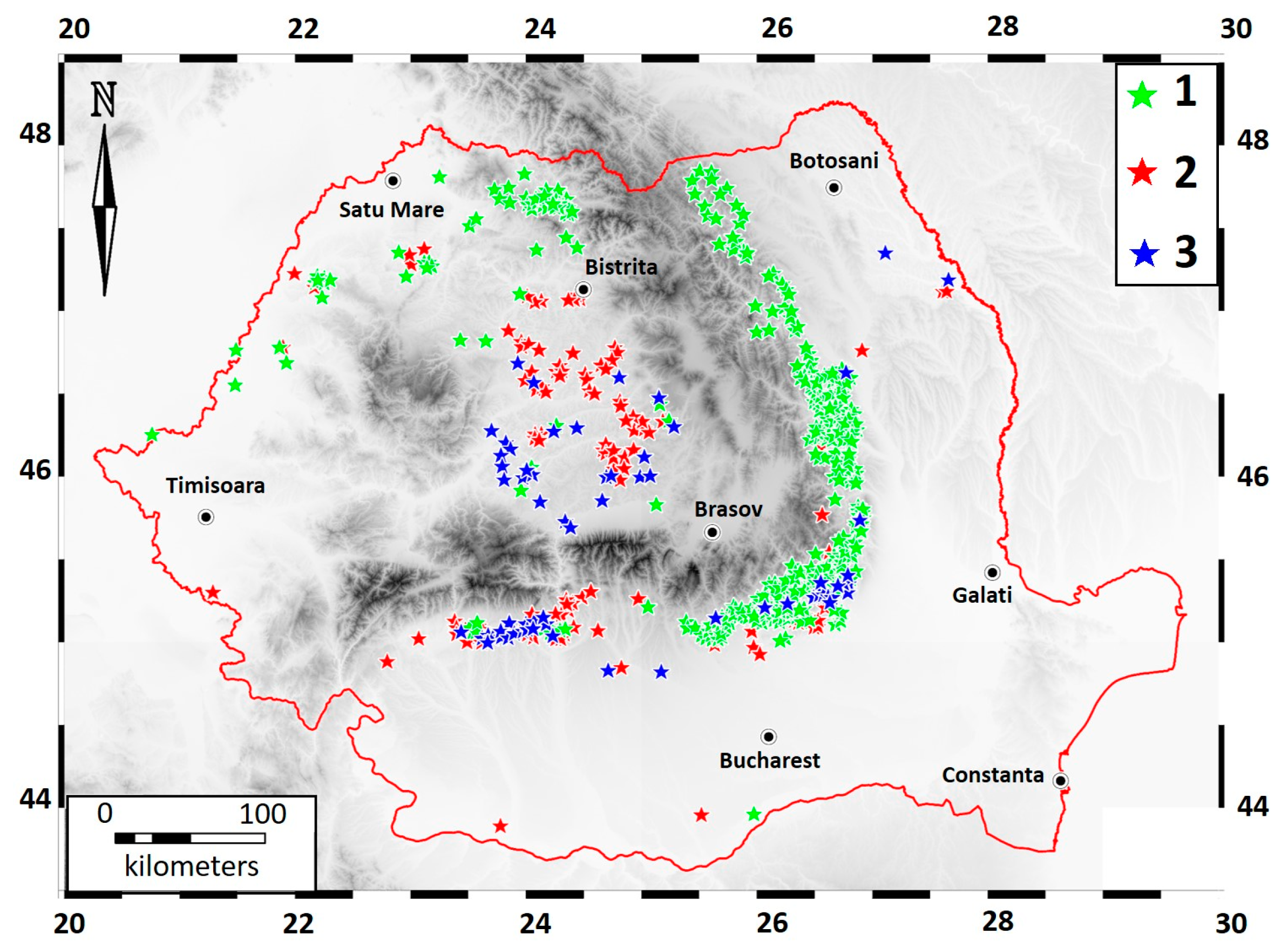

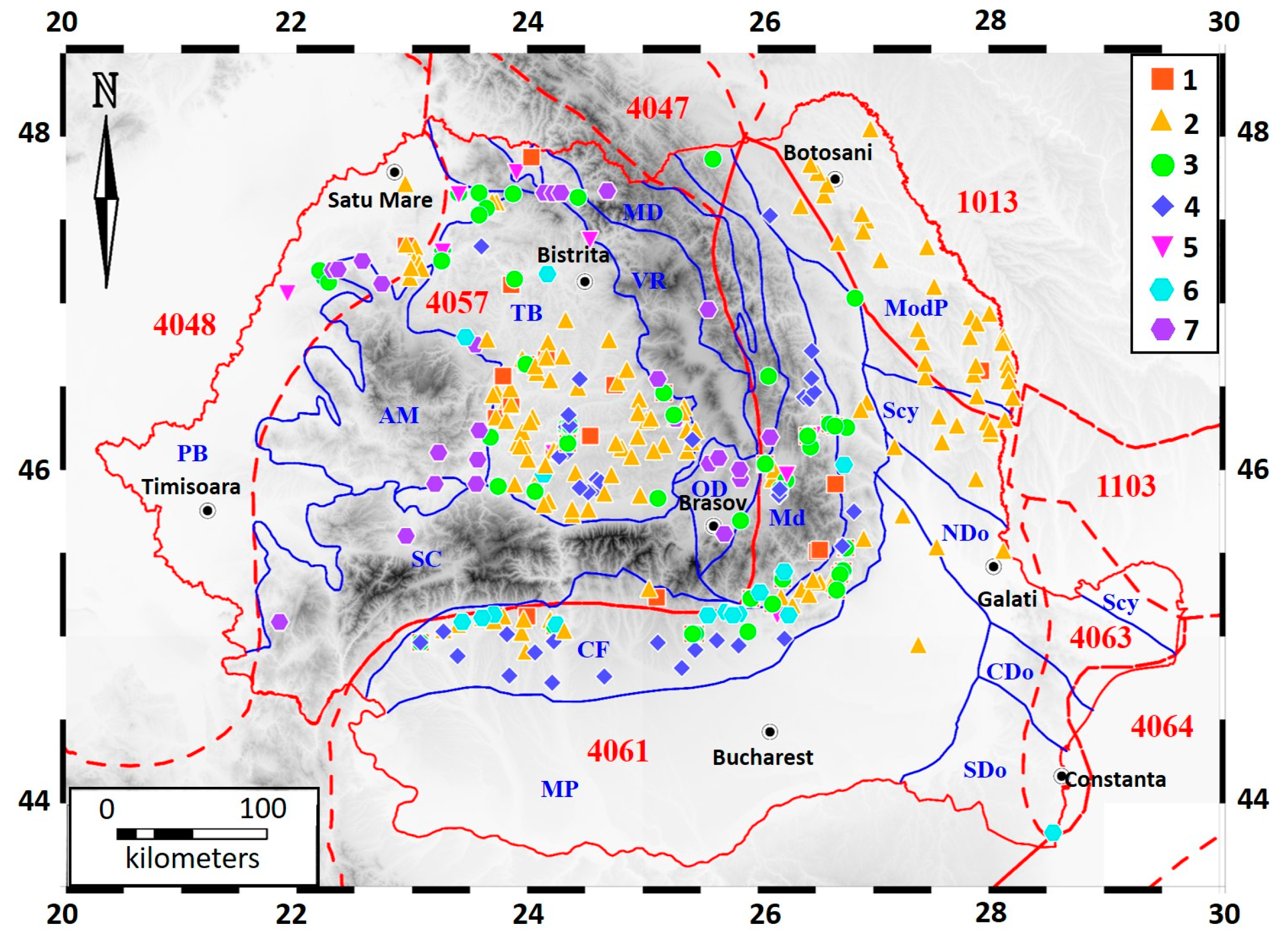


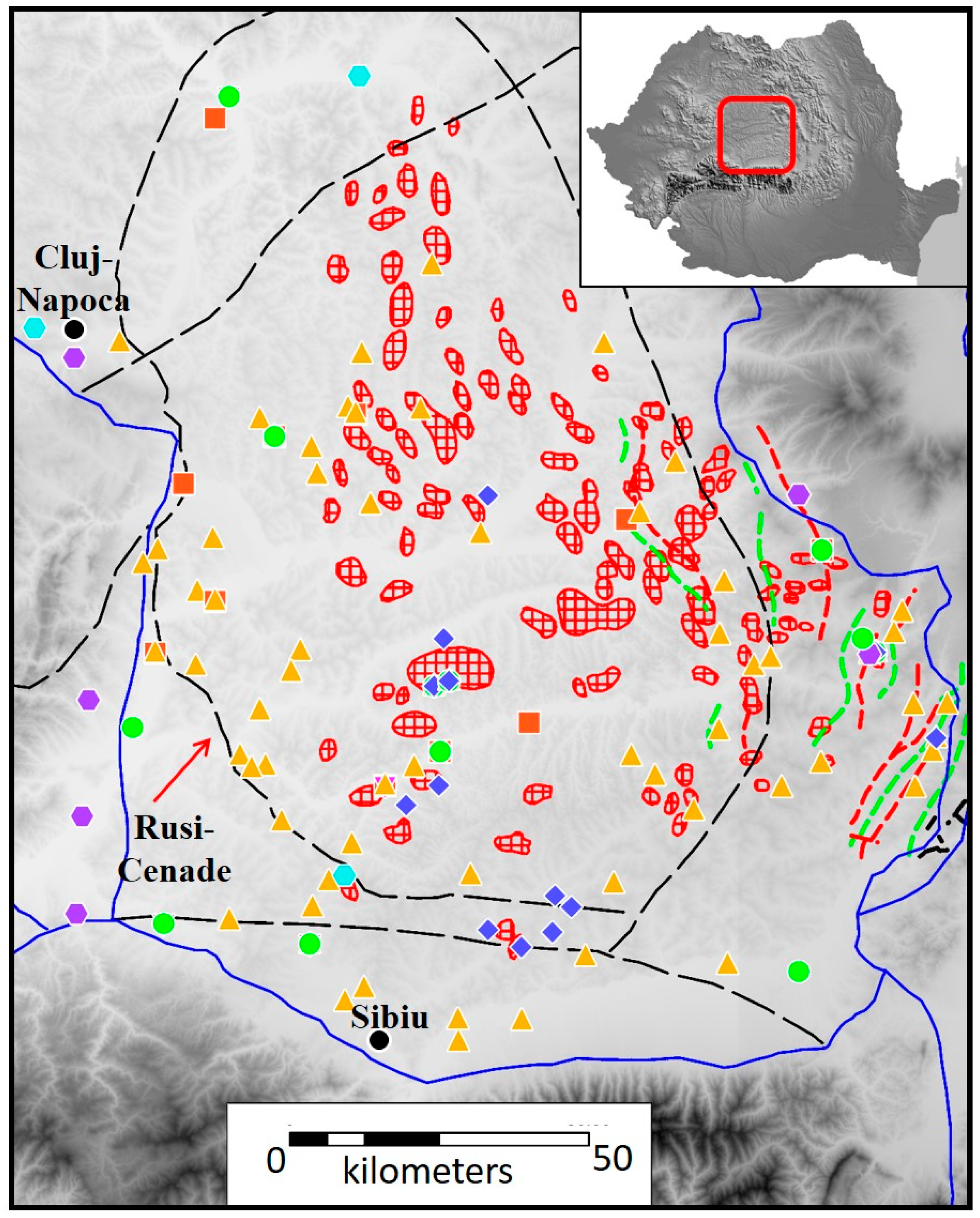


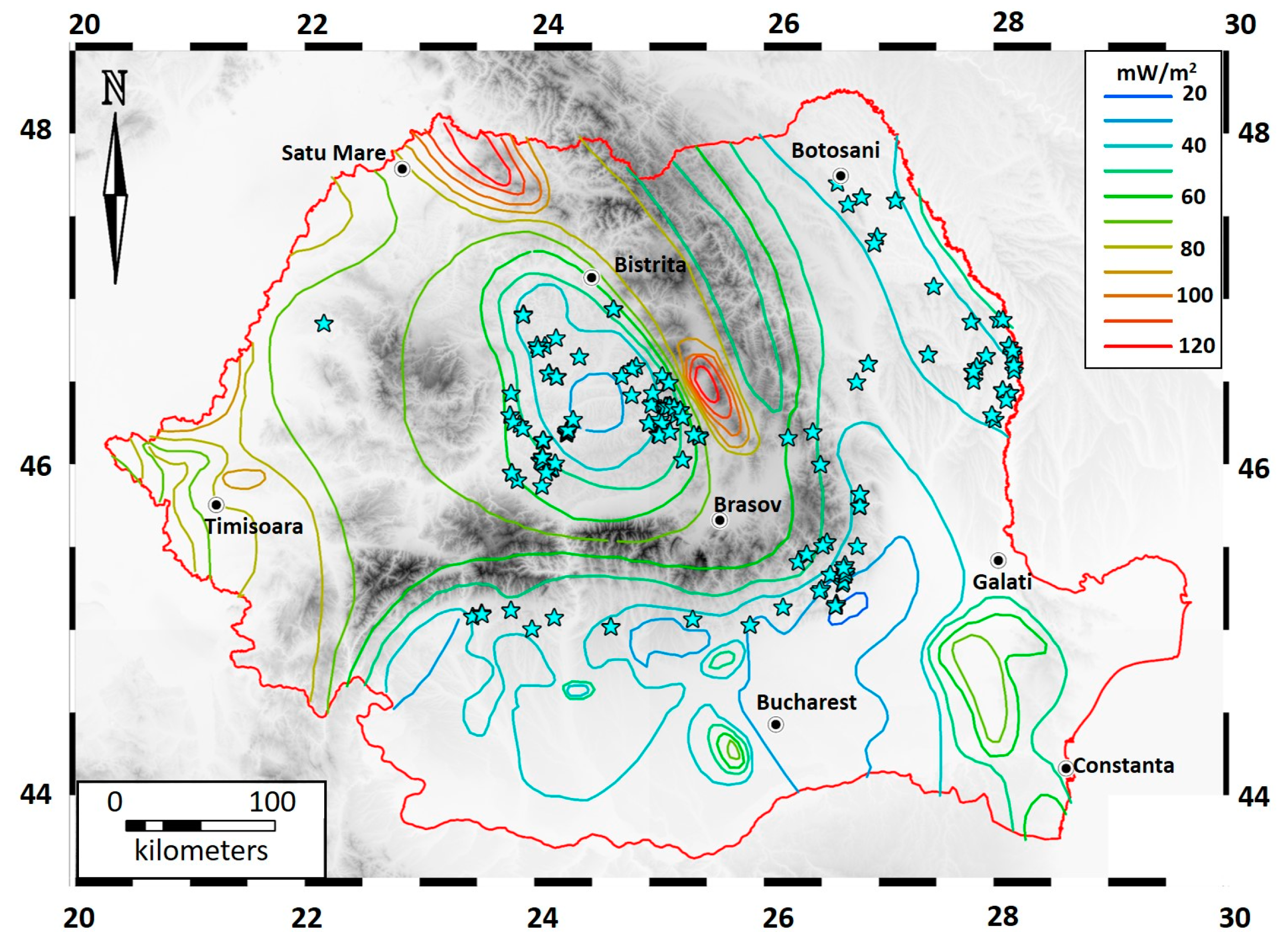
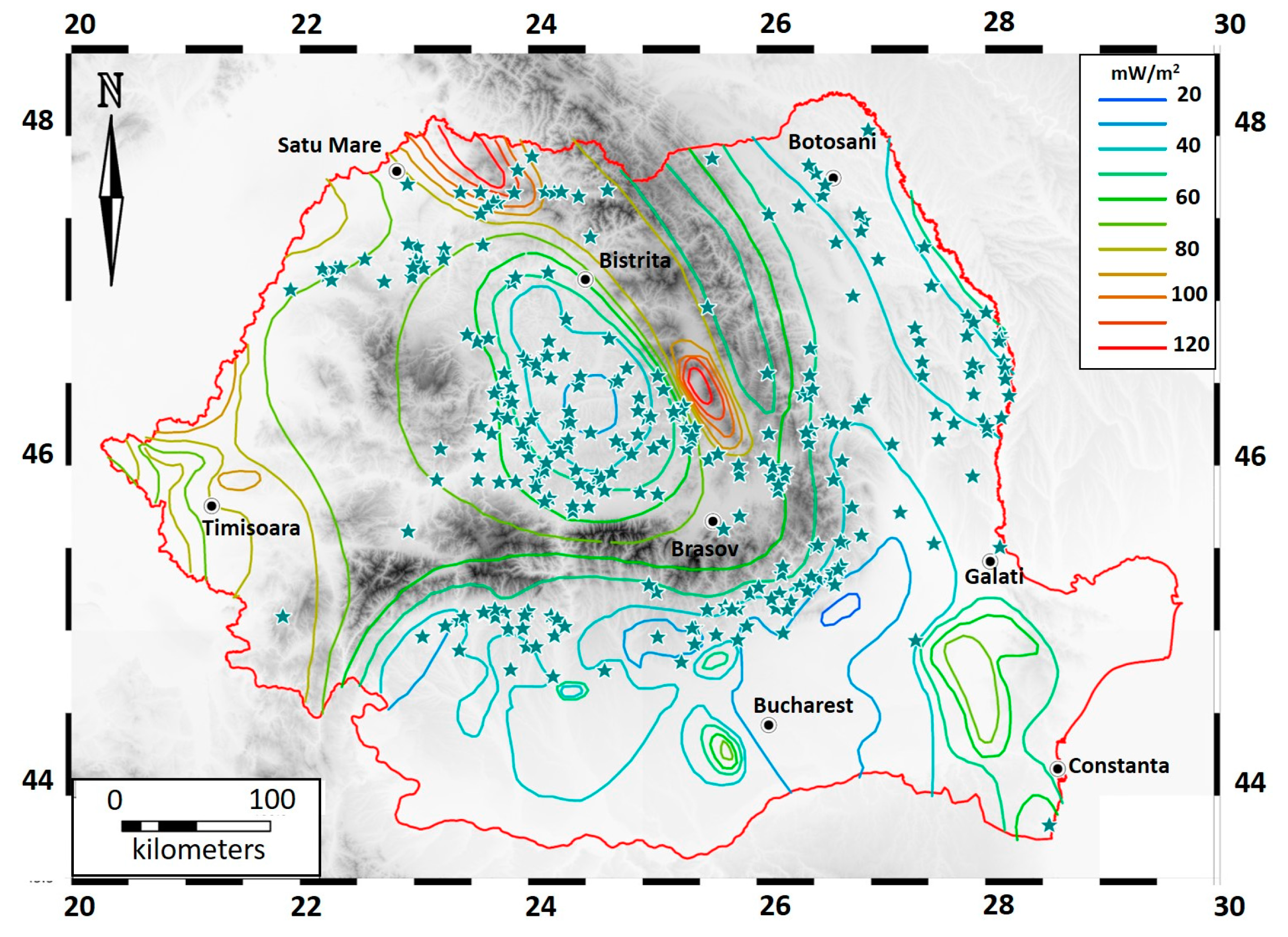
| No. | Field | Variable | Description |
|---|---|---|---|
| Section 1 (publicly available) | |||
| 1 | ID | Char (n) | Identification number for each individual seep. |
| 2 | Name | Char (n) | The name of the seep or the name of the nearest settlement. |
| 3 | Province | Char (n) | Refers to one of the seven geologic provinces defined by the USGS that cover Romania (Figure 2) [45]. |
| 4 | Type | Char (n) | Refers to the type of manifestation: gas seep, mud volcanoes, oil seep, hydrocarbon-bearing spring (water seep), solid seeps (asphalt), unclassified manifestation and uncertain seeps. |
| 5 | Status | Char (n) | Refers to the activity of the seep: active, inactive or unknown activity. |
| 6 | Latitude | Dec (n, m) | GPS location, in decimal degrees. |
| 7 | Longitude | Dec (n, m) | |
| 8 | Reference | Char (n) | The source of information: author(s) and year |
| Section 2 (available on request) | |||
| 9 | Area | Dec (n, m) | Investigated area (m2) |
| 10 | Flux | Dec (n, m) | CH4, CO2 (g m−2 d−1) |
| 11 | Molecular (gas) | Char (n) Dec (n, m) | Molecular analysis of gas |
| 12 | Isotopes (gas) | Char (n) Dec (n, m) | Isotopic analysis of gas |
| 13 | Chemical (water) | Char (n) Dec (n, m) | Chemical analysis of water (physico-chemical properties, major ions, metals, etc.) |
| 14 | Isotopes (water) | Char (n) Dec (n, m) | Isotopic analysis of water (δ2H, δ18O, δ13C-DIC) |
| 15 | Others | Char (n) Dec (n, m) | Minor gases, special features, etc. |
| Type | Active | Inactive | Unknown Activity | Total |
|---|---|---|---|---|
| Mud volcano | 64 | 21 | 152 | 237 |
| Gas | 13 | 2 | 34 | 49 |
| Spring | 17 | 0 | 42 | 59 |
| Oil seep | 4 | 0 | 51 | 55 |
| Solid seep | 0 | 0 | 20 | 20 |
| Unclassified manifestation | 0 | 0 | 19 | 19 |
| Uncertain | 0 | 0 | 31 | 31 |
| Total | 98 | 27 | 349 | 470 |
© 2017 by the authors. Licensee MDPI, Basel, Switzerland. This article is an open access article distributed under the terms and conditions of the Creative Commons Attribution (CC BY) license (http://creativecommons.org/licenses/by/4.0/).
Share and Cite
Ionescu, A.; Burrato, P.; Baciu, C.; Etiope, G.; Kis, B.-M. Inventory of Onshore Hydrocarbon Seeps in Romania (HYSED-RO Database). Geosciences 2017, 7, 39. https://doi.org/10.3390/geosciences7020039
Ionescu A, Burrato P, Baciu C, Etiope G, Kis B-M. Inventory of Onshore Hydrocarbon Seeps in Romania (HYSED-RO Database). Geosciences. 2017; 7(2):39. https://doi.org/10.3390/geosciences7020039
Chicago/Turabian StyleIonescu, Artur, Pierfrancesco Burrato, Calin Baciu, Giuseppe Etiope, and Boglarka-Mercedesz Kis. 2017. "Inventory of Onshore Hydrocarbon Seeps in Romania (HYSED-RO Database)" Geosciences 7, no. 2: 39. https://doi.org/10.3390/geosciences7020039







